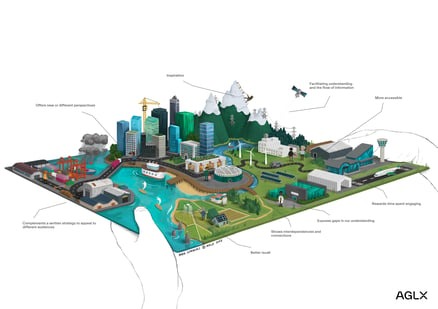
Adaptive Strategy is best presented visually. Just as a map allows an explorer to make sense of the landscape and plan a potential path forward, an illustration allows the viewer to understand strategy in a more comprehensive way. A written strategy is more like a set of directions. It can be used for journey planning but does not allow the traveller alternatives or options.
Research by Angwin and Cummings (2019) shows that the presentation of visual elements alongside a written strategy led to increased recall and understanding. A study by Epler and Platts (2009) showed that multimedia depictions of strategy offered benefits across three categories – cognitive (e.g. better recall), emotional (e.g. increased engagement and inspiration), and social (e.g. facilitating mutual understanding).
Conversely, the research also shows that visual elements accompanying a strategy can increase uncertainty in some viewers as they grapple with the complexity of the intersecting ideas.
A written strategy often appears clear and provides the reader with a false sense of certainty. Your strategic environment is often uncertain, a visual strategy offers us an opportunity to avoid the pitfalls of overconfidence and seek greater understanding as we explore the strategic landscape.
The AGLX visual strategy service is built on these ideas. Supplementing a written strategy with a visual depiction challenges people to interact and seek out new meaning, while also offering greater accessibility to those who may not be inclined to read long documents.
A visual strategy is not a roadmap with a start point and a destination. Instead, it will show the complexity of the interactions and connections between different elements, start conversations, and encourage people to spend time and engage with the information from a new perspective.
References:
Martin J. Eppler, Ken W. Platts (2009). Visual Strategizing: The Systematic Use of Visualization in the Strategic-Planning Process, Long Range Planning, Volume 42, Issue 1, Pages 42-74,
https://doi.org/10.1016/j.lrp.2008.11.005
Angwin, Duncan N; Cummings, Stephen; Daellenbach, Urs (2019): How the Multimedia Communication of Strategy Can Enable More Effective Recall and Learning. Open Access Te Herenga Waka-Victoria University of Wellington.

